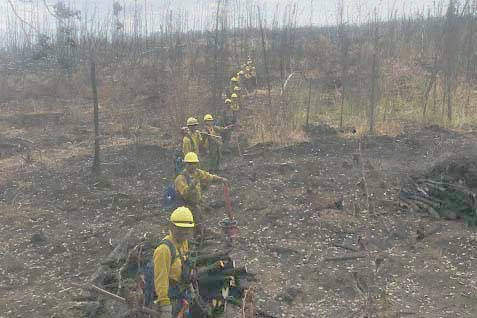Last year at this time, some of the worst of the wildfire season on the Kenai Peninsula was yet to come.
Just how different this summer’s wildfire season has been was highlighted July 28, when the Alaska Division of Forestry sent about 20 members of the Kenai Peninsula’s Yukon Fire Crew to California to help on the Apple Fire there.
“That’s the way it typically works,” said Tim Mowry, public information officer for the Alaska Division of Forestry. “We have an earlier wildfire season than the rest of the United States.”
Last year was not typical.
According to the Swan Lake Fire – Story Map, as of July 16 that fire had surpassed 100,000 acres. It increased just 1,213 acres between July 15 and 30, and another 292 acres between July 31 and Aug. 15. On Aug. 18, high winds flared the fire to 138,479 acres.
According to Division of Forestry, the Swan Lake Fire, started June 5 by lightning, ended up burning 167,164 acres and burned for five months. The fire needed $50 million in suppression costs, but did not burn any homes or cause any serious injuries.
Mowry said that last summer featured extended hot and dry weather that made the extended life of the Swan Lake Fire possible.
“This year has been the opposite end of the spectrum,” he said.
As of Monday morning, Mowry said statewide 319 wildfires had burned 179,726 acres. On the peninsula, 49 fires had burned 20.8 acres.
Mowry said the average for the state is about 500 fires and 650,000 acres per year.
Last year in Alaska, 743 fires burned 2.6 million acres.
According to a post on the Division of Forestry Facebook page, last year’s fires ranked as No. 11 since 1939 in terms of acres burned. Five of the top 11 years have come since 2000.
Currently, this fire season ranks 55th out of the 88 seasons on record.
Mowry said the tamer wildfire season came at a good time due to the new coronavirus pandemic.
“Thankfully, we didn’t have a fire season like last year and have to import thousands of firefighters from the Lower 48,” he said. “That could have caused a lot more problems.”
Mowry said the Alaska Division of Forestry spent a lot of time early in the season on training, safety and protocols revolving around how to keep firefighters from getting COVID-19.
He said nine crews were brought up from the Lower 48 in early June and all tested negative for COVID-19 upon arrival.
“We spent a lot of time and energy figuring out how to sanitize engines and helicopters, and how to set up fire camps,” Mowry said.
Mowry said the lighter fire season allows crews to work on other projects, like hazard mitigation. When crews go to the Lower 48, they get a chance to gain more experience fighting fire and also make money that gets brought back to the Alaska economy.
Though August has gotten off to a rainy start, Mowry said that wildfire season is not over.
Even with just over 200 firefighters in the Lower 48, Alaska Division of Forestry still has firefighters showing up to work every day ready to take all calls about potential burns and staff an initial attack on the fire. The Alaska fire crews can be called back to their home state an any time.
“With the long-range weather models and the fuel indices, there’s nothing showing us that any change in weather is coming, and that’s turned out to be true so far,” Mowry said.
Mowry gave credit to Alaskans for being careful with burning this summer, but said it’s still important to burn slash piles with care and make sure campfires are cold to the touch before leaving them.
“I’d like to think last year was weighing heavily on people’s minds and maybe they were a little more careful early in the season with fire,” Mowry said.
Although the weather wasn’t great for wildfires, Mowry did point out the Kenai Peninsula had a ban on burn permits in effect from May 1 to July 7, showing there was definitely wildfire risk. With this summer’s burn ban coming on the heels of last summer’s potent wildfire season, Mowry said there could be a backlog of slash to burn on the peninsula.
“Now is a good time to burn and get rid of stuff,” he said. “Who knows what next year’s going to be like? We’re not encouraging people to store a brush pile to burn next year if they can burn it now.”

